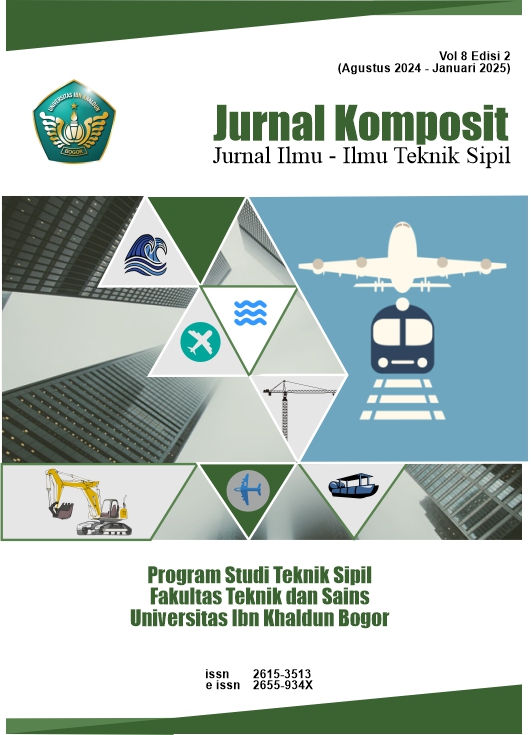Analisis Pengaruh Abu Tempurung Kelapa terhadap Kuat Tekan Beton Memadat Sendiri (Self Compacting Concrete)
DOI:
https://doi.org/10.32832/komposit.v8i2.15692Abstrak
Penelitian dalam industri beton bertujuan untuk meningkatkan kualitas beton dengan menggunakan teknologi dan teknik canggih. Salah satu inovasi yang dilakukan adalah dengan penggunaan bahan tambah pada beton SCC, yaitu abu tempurung kelapa. Penelitian ini menggunakan abu tempurung kelapa sebagai bahan tambah dengan proporsi abu tempurung kelapa yang digunakan adalah 0%, 5%, 15%, dan 25% terhadap berat semen dengan akuran agregat maksimum 20 mm. Acuan yang digunakan dalam pembuatan campuran beton adalah Mix Design EFNARC dengan kuat tekan rencana (f’c) 20 MPa. Benda uji berbentuk silinder dengan ukuran diameter 15 cm dan tinggi 30 cm. Pengujian yang dilakukan yaitu uji tekan dengan perawatan selama 14 dan 28 hari. Hasil dari penambahan abu tempurung kelapa pada beton SCC memberikan pengaruh terhadap karakteristik workability beton berupa nilai slump flow maksimum pada variasi beton SCC0 tanpa tambahan abu tempurung kelapa sebesar 650 mm dan nilai slump flow minimum terdapat pada variasi beton tanpa campuran (BN) sebesar 330 mm dan hasil dari pengujian v-funnel mengalami penurunan waktu mengalir seiring bertambahnya abu tempurung kelapa, hal ini disebabkan oleh semakin tingginya persentase abu tempurung kelapa yang digunakan, maka sifat beton akan semakin kental. Hasil nilai perbandingan beton tanpa campuran (BN) dan beton SCC dengan variasi penambahan abu tempurung kelapa terhadap kuat tekan beton pada umur 14 dan 28 hari diperoleh penurunan nilai kuat tekan beton seiring dengan bertambahnya persentase penggunaan abu tempurung kelapa. Penurunan nilai kuat tekan beton tanpa campuran (BN) terhadap beton variasi paling tinggi terjadi pada variasi SCCA25 sebesar 55,50% pada umur 14 hari dan 61,06% pada umur 28 hari.
Referensi
Arfan, M., Fadhilah, M., & Irfan, M. (2022). Pengaruh Kadar Abu Tempurung Kelapa Terhadap Sifat Fleksural dan Karakteristik Aliran Beton Self-Compacting Concrete (SCC). Jurnal Teknik Sipil Universitas Syiah Kuala, 16.
Azizi, R., Purwandito, M., & Alamsyah, W. (2022). Uji Kuat Tekan Mortar dengan Menambahkan PCM Lilin Lebah – Getah Damar. Jurnal Media Teknik Sipil Samudra, 3(2), 1–10. https://doi.org/https://doi.org/10.55377/jmtss.v3i2.5039
Cahyaka, H. W., Wibowo, A., Handayani, K. D., Wiyono, A., & Santoso, E. H. (2018). Pengaruh Penambahan Abu Ampas Tebu sebagai Material Pengganti Semen pada Campuran Beton Self Compacting Concrete (SCC) terhadap Kuat Tekan dan Porositas Beton. Jurnal Rekayasa Teknik Sipil, 1(1), 186–194.
do Rego, A. J., & Zulaicha, L. (2022). Pengaruh Penambahan Abu Tempurung Kelapa Terhdap Kuat Tekan dan Kuat Tarik Beton. Equilib, 03(01), 115–123.
EFNARCH. (2002). Specification and Guidelines for Self-Compacting Concrete. In Magazine of Concrete Research (Vol. 64, Issue 5). https://doi.org/10.1680/macr.10.00167
Hajrin, S., Merdana, I. N., & Eniarti, M. (2023). Pengaruh Pemanfaatan Abu Tempurung Kelapa (Coconut Shell Ash) sebagai Bahan Tambah terhadap Kuat Tekan Beton Memadat Sendiri (Self Compacting Concrete) [Universitas Mataram]. http://eprints.unram.ac.id/39292/
Hidayat, N. A., Herlina, N., & Nursani, R. (2021). Analisa Karakteristik Kuat Tekan Beton Fc’25 MPa dengan Menggunakan Bahan Tambah Gula Merah. Akselerasi: Jurnal Ilmiah Teknik Sipil, 3(1), 1–11.
Prayogi, A. (2021). Pengaruh Campuran Abu Sekam Padi dan Abu Arang Tempurung sebagai Pengganti Sebagian Agregat Halus terhadap Kuat Tekan Beton. Structure Technology Management Journal, 1(1), 1–9. https://doi.org/https://doi.org/10.32520/stmj.v1i1.1487
Rusyandi, K., Mukodas, J., & Gunawan, Y. (2012). Perancangan Beton Self Compacting Concrete (Beton Memadat Sendiri) Dengan Penambahan Fly Ash dan Structuro. Jurnal Konstruksi, 10(01), 1–11. https://doi.org/10.33364/konstruksi/v.10-01.35
Tjokrodimuljo, K. (2009). Teknologi Beton. Biro Penerbit KMTS FT UGM.
Wongso, D., Mungok, C. D., & Supriyadi, A. (2013). Studi Perancangan Self-compacting Concrete (SCC) Untuk Beton Berkekuatan Tinggi (High Performance Concrete) dengan Metode ACI. Jurnal Mahasiswa Teknik Sipil Universitas Tanjungpura, 1(1), 1–9. https://doi.org/http://dx.doi.org/10.26418/jelast.v1i1.2308
Unduhan
Diterbitkan
Cara Mengutip
Terbitan
Bagian
Lisensi
Hak Cipta (c) 2024 Jurnal Komposit: Jurnal Ilmu-ilmu Teknik Sipil

Artikel ini berlisensiCreative Commons Attribution-NonCommercial-ShareAlike 4.0 International License.
Authors who publish with this journal agree to the following terms (Penulis yang mengajukan publikasi artikel telah menyetujui hal berikut):
- Through this publication, the author agree to submit the copyright of article writing to Jurnal Komposit: Jurnal Ilmu-ilmu Teknik Sipil. This copyright submission takes the form of, but is not limited to: reproduction of the article and parts therein, including photographic reproductions; distribution of articles through printed and electronic documents; and translation of articles(Bahwa melalui publikasi ini, hak cipta penulisan artikel diserahkan kepada Jurnal Komposit: Jurnal Ilmu-ilmu Teknik Sipil. Penyerahan hak cipta ini berupa, namun tidak terbatas pada: perbanyakan artikel dan bagian di dalamnya, termasuk reproduksi fotografi; penyebarluasan artikel melalui dokumen cetak dan elektronik; serta penterjemahan artikel).
- The authors agree to the terms of the Copyright Notice, according to Creative Commons Attribution-NonCommercial-ShareAlike 4.0 International License., which will apply to this article if and when it is published by Jurnal Komposit: Jurnal Ilmu-ilmu Teknik Sipil. (Para penulis setuju dengan ketentuan Pemberitahuan Hak Cipta, sesuai dengan Lisensi Internasional Creative Commons Attribution-NonCommercial-ShareAlike 4.0., yang akan berlaku untuk artikel ini jika dan ketika diterbitkan oleh Jurnal Komposit: Jurnal Ilmu-ilmu Teknik Sipil).

This work is licensed under a Creative Commons Attribution-NonCommercial-ShareAlike 4.0 International License.



.png)










